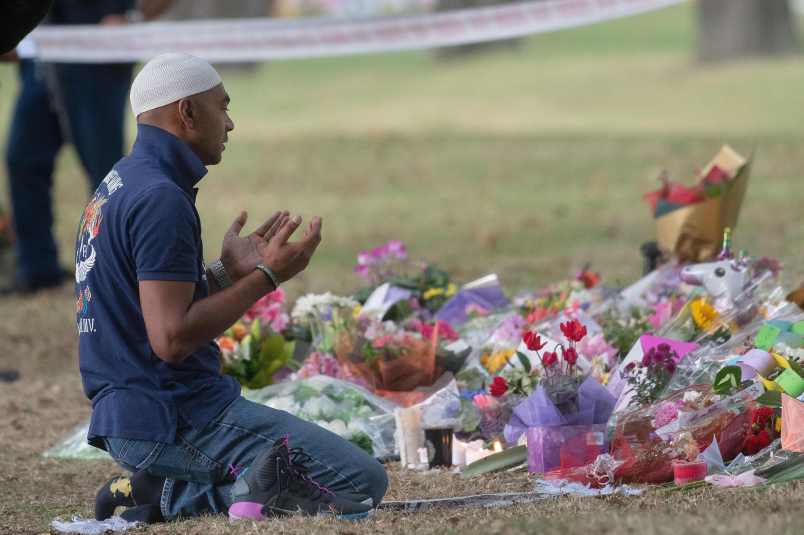In the immediate aftermath of the Christchurch mosque attacks, President Donald Trump said only a “small group of people that have very, very serious problems” adhere to white nationalist ideology.
But experts who study far-right extremism say that the Trump administration is ignoring the clear and present danger posed by racist violence. Though inadequate and inconsistent tracking of these crimes makes it more difficult to accurately assess them, experts told TPM, the numbers that do exist show, unequivocally, that far-right extremist violence is on the rise.
“All the data we’re looking at indicate a rise in violence from far-right groups,” Seth Jones, director of the Transnational Threats Project at the Center for Strategic and International Studies (CSIS) told TPM. “The data suggests an increase. Period.”
Over the decades, far-right violence has “ebbed and flowed in waves,” Jones continued, “and it looks like we’re at a period where the waves are gathering some momentum.”
A November 2018 CSIS study charted this global increase. In the U.S., terror attacks by right-wing extremists numbered five or less annually between 2007 and 2011, hovered around 14 annually between 2012 and 2016, and jumped to 31 in 2017, according to the Global Terrorism Database at the University of Maryland. In Europe, the number of right-wing attacks tracked by the European Union Agency for Law Enforcement Cooperation grew from zero in 2012 to nine in 2013 to 21 in 2016. 2017 saw 30 such attacks.
Groups like the Anti-Defamation League, which track extremist groups, have closely monitored this trend. A recent ADL report found that right-wing extremists committed every single extremist-related murder in the U.S. in 2018, mostly using firearms.
Michael German, a former FBI counterterrorism agent now with the Brennan Center, cautioned that these numbers can be unreliable because different entities qualify these crimes differently. A non-profit may cite higher numbers than the FBI, or distinct non-profits may classify “extremist” attacks differently.
“The problem is we have a system in the United States that, because of Justice Department policies, tends to hide these crimes in different categories,” German said. “So it’s very hard to conduct any kind of comprehensive examination of data that doesn’t exist.”
As German pointed out, “far-right violence is sometimes called domestic terrorism, it’s sometimes called hate crimes, it’s sometimes called gang violence.”
Such shoddy record-keeping makes it difficult “to get a balanced grasp of the threat level posed by the extreme right,” as Daniel Koehler, director of the German Institute on Radicalization and Deradicalization Studies put it in a 2019 report.
Exact numbers aside, experts agree we’re in a historical moment where that global threat level is high.
The last few years have seen a white nationalist gun down nine parishioners at a South Carolina church; an anti-Semite go on a shooting spree at a Pittsburgh temple; a white nationalist run over a peaceful protester with his car; and multiple school shootings by teenagers who expressed racist, hateful views. Overseas, a liberal British politician was assassinated by a far-right extremist shouting “Britain first”; a Norwegian white nationalist murdered 77 people in a coordinated attack; a man plowed a van into Muslim worshippers outside a London mosque; and New Zealand just saw it’s “darkest day” with the Christchurch murders.
The causes are overlapping and self-reinforcing, experts say.
A mass migration crisis in Europe that reached its peak in 2013 prompted “pushback not just from the far-right but from populist politicians in a number of different countries,” the CSIS’ Jones said. Far-right entities from the pro-Brexit UKIP party to the Trump campaign gained political power by stoking racial resentments.
While white nationalists have long thrived on the Internet, they’ve expanded their use of social media platforms to recruit new members, promote their ideas, and organize on-the-ground activities, including violent events like the Charlottesville rally.
Particularly in the U.S., far-right extremist attackers have embraced the use of high-powered automatic assault rifles to inflict the most damage possible on their victims in a short amount of time.
“What is unique is the weaponry,” Mark Hamm, an expert on terrorism at Indiana University, told TPM.
“It’s not just the availability, but it’s the tendency—and this is really new—of these lone shooters to overarm themselves,” Hamm continued.
New Zealand shooter Brenton Tarrant reportedly had five guns on his person during Friday’s attack, Hamm noted: “He’s trying to build confidence, trying to create a feeling of omnipotence over his targets. So this is new.”
FBI Director Chris Wray disclosed at a Senate Homeland Security hearing last year that the bureau had 1,000 active investigations into domestic terrorism, predicting that “law enforcement, racial minorities, and the U.S. Government” will remain extremists’ primary targets.
But the FBI, Justice Department, cable news terror experts and even academics still tend to prioritize the threat posed by groups like ISIS and Al Qaeda, experts told TPM. While that balance is starting to shift, years of high-octane fear-mongering about the dangers posed by Sharia-promoting Muslim immigrants can’t be erased overnight. A 2018 study from the University of Alabama found that terrorist attacks committed by Muslims receive some 357 percent more news coverage than other attacks.
Trump has only made matters worse, frequently demonizing the immigrants, Muslims, and racial minorities most likely to be targeted. There “were very fine people, on both sides,” Trump infamously said of Charlottesville. On the day of the New Zealand shooting, the President, like Tarrant, complained of an “invasion” of “illegal aliens.”
Koehler, the German terrorism expert, has written that right-wing terrorism poses a more corrosive threat to Western democracies than other forms of terrorist violence “because the underestimation by the authorities essentially proves right the suspicion of minorities and other at-risk groups that they are without equal protection.”
The Trump administration’s response to Christchurch is just the latest affirmation.










